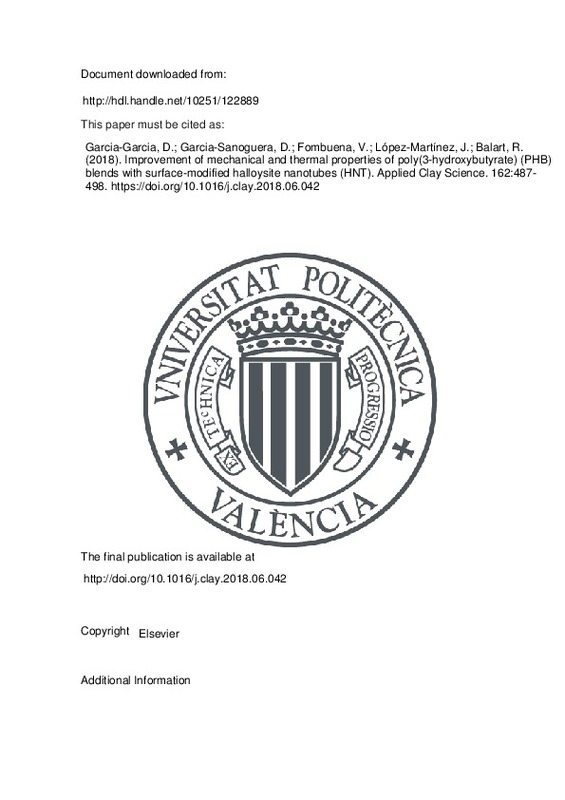JavaScript is disabled for your browser. Some features of this site may not work without it.
Buscar en RiuNet
Listar
Mi cuenta
Estadísticas
Ayuda RiuNet
Admin. UPV
Improvement of mechanical and thermal properties of poly(3-hydroxybutyrate) (PHB) blends with surface-modified halloysite nanotubes (HNT)
Mostrar el registro sencillo del ítem
Ficheros en el ítem
| dc.contributor.author | Garcia-Garcia, D.
|
es_ES |
| dc.contributor.author | Garcia-Sanoguera, David
|
es_ES |
| dc.contributor.author | Fombuena, Vicent
|
es_ES |
| dc.contributor.author | López-Martínez, Juan
|
es_ES |
| dc.contributor.author | Balart, Rafael
|
es_ES |
| dc.date.accessioned | 2019-06-28T20:04:58Z | |
| dc.date.available | 2019-06-28T20:04:58Z | |
| dc.date.issued | 2018 | es_ES |
| dc.identifier.issn | 0169-1317 | es_ES |
| dc.identifier.uri | http://hdl.handle.net/10251/122889 | |
| dc.description.abstract | [EN] The effect of two hydrophobic treatments on the hydrophilic nature of halloysite nanotubes (HNT) was studied in this research work: a silanization with (3-glycidyloxypropyl) trimethoxysilane (GLYMO) and a surface treatment with a natural aromatic compound, i.e. caffeic acid (CA). In addition, the effect of 3¿wt% of unmodified HNT, silanized HNT (HNTSIL) and caffeic acid-modified HNT (HNTCA) on mechanical, thermal and morphological properties of a binary blend of poly(3-hydroxybutyrate) (PHB) and poly(¿-caprolactone) (PCL) with a weight ratio of 75/25, respectively was evaluated. These blends and their corresponding composites with HNT were partially compatibilized by reactive extrusion with dicumyl peroxide (DCP) and further processed by injection molding. The effectiveness of the surface treatments on HNT was followed by Fourier transformed infrared spectroscopy (FTIT), thermogravimetric analysis (TGA), field emission scanning electron microscopy (FESEM) and contact angle measurements. The obtained results suggested a clear hydrophobizing effect of both surface treatments on HNT but the hydrophobic nature the caffeic acid treatment can provide to HNT is greater than silanization. FESEM study on HNT-loaded PHB/PCL blends showed increased compatibility between modified-HNT and the polymeric matrix, as well as a better particle dispersion. In particular, 3¿wt% HNTCA lead to an increase in tensile strength and elongation at break of 11.4% and 74%, respectively, with regard to composites with unmodified HNT. In addition, thermal analysis, evaluated by differential scanning calorimetry (DSC) and thermogravimetric analysis (TGA), revealed a decrease in the melt peak temperature of 6.5¿°C for composites with 3¿wt% HNTCA as well a delay in the onset degradation temperature, thus leading to a broader processing window which enhances PHB processing by conventional techniques. | es_ES |
| dc.description.sponsorship | This work was supported by the Ministry of Economy and Competitiveness (MINECO) [MAT2017-84909-C2-2-R]. D. Garcia-Garcia wants to thank the Spanish Ministry of Education, Culture and Sports for the financial support through a FPU grant [FPU13/06011]. | es_ES |
| dc.language | Inglés | es_ES |
| dc.publisher | Elsevier | es_ES |
| dc.relation.ispartof | Applied Clay Science | es_ES |
| dc.rights | Reconocimiento - No comercial - Sin obra derivada (by-nc-nd) | es_ES |
| dc.subject | Poly(3-hydroxybutyrate) | es_ES |
| dc.subject | Poly(ε | es_ES |
| dc.subject | -caprolactone) | es_ES |
| dc.subject | Dicumyl peroxide | es_ES |
| dc.subject | Halloysite nanotubes | es_ES |
| dc.subject | Silane | es_ES |
| dc.subject | Caffeic acid | es_ES |
| dc.subject.classification | CIENCIA DE LOS MATERIALES E INGENIERIA METALURGICA | es_ES |
| dc.subject.classification | INGENIERIA QUIMICA | es_ES |
| dc.title | Improvement of mechanical and thermal properties of poly(3-hydroxybutyrate) (PHB) blends with surface-modified halloysite nanotubes (HNT) | es_ES |
| dc.type | Artículo | es_ES |
| dc.identifier.doi | 10.1016/j.clay.2018.06.042 | es_ES |
| dc.relation.projectID | info:eu-repo/grantAgreement/AEI/Plan Estatal de Investigación Científica y Técnica y de Innovación 2013-2016/MAT2017-84909-C2-2-R/ES/PROCESADO Y OPTIMIZACION DE MATERIALES AVANZADOS DERIVADOS DE ESTRUCTURAS PROTEICAS Y COMPONENTES LIGNOCELULOSICOS/ | es_ES |
| dc.relation.projectID | info:eu-repo/grantAgreement/MECD//FPU13%2F06011/ES/FPU13%2F06011/ | es_ES |
| dc.rights.accessRights | Abierto | es_ES |
| dc.contributor.affiliation | Universitat Politècnica de València. Departamento de Ingeniería Mecánica y de Materiales - Departament d'Enginyeria Mecànica i de Materials | es_ES |
| dc.contributor.affiliation | Universitat Politècnica de València. Departamento de Ingeniería Química y Nuclear - Departament d'Enginyeria Química i Nuclear | es_ES |
| dc.contributor.affiliation | Universitat Politècnica de València. Instituto de Tecnología de Materiales - Institut de Tecnologia de Materials | es_ES |
| dc.description.bibliographicCitation | Garcia-Garcia, D.; Garcia-Sanoguera, D.; Fombuena, V.; López-Martínez, J.; Balart, R. (2018). Improvement of mechanical and thermal properties of poly(3-hydroxybutyrate) (PHB) blends with surface-modified halloysite nanotubes (HNT). Applied Clay Science. 162:487-498. https://doi.org/10.1016/j.clay.2018.06.042 | es_ES |
| dc.description.accrualMethod | S | es_ES |
| dc.relation.publisherversion | http://doi.org/10.1016/j.clay.2018.06.042 | es_ES |
| dc.description.upvformatpinicio | 487 | es_ES |
| dc.description.upvformatpfin | 498 | es_ES |
| dc.type.version | info:eu-repo/semantics/publishedVersion | es_ES |
| dc.description.volume | 162 | es_ES |
| dc.relation.pasarela | S\366167 | es_ES |
| dc.contributor.funder | Ministerio de Educación | es_ES |
| dc.contributor.funder | Ministerio de Economía y Empresa | es_ES |
| dc.contributor.funder | Agencia Estatal de Investigación | es_ES |







![[Cerrado]](/themes/UPV/images/candado.png)

